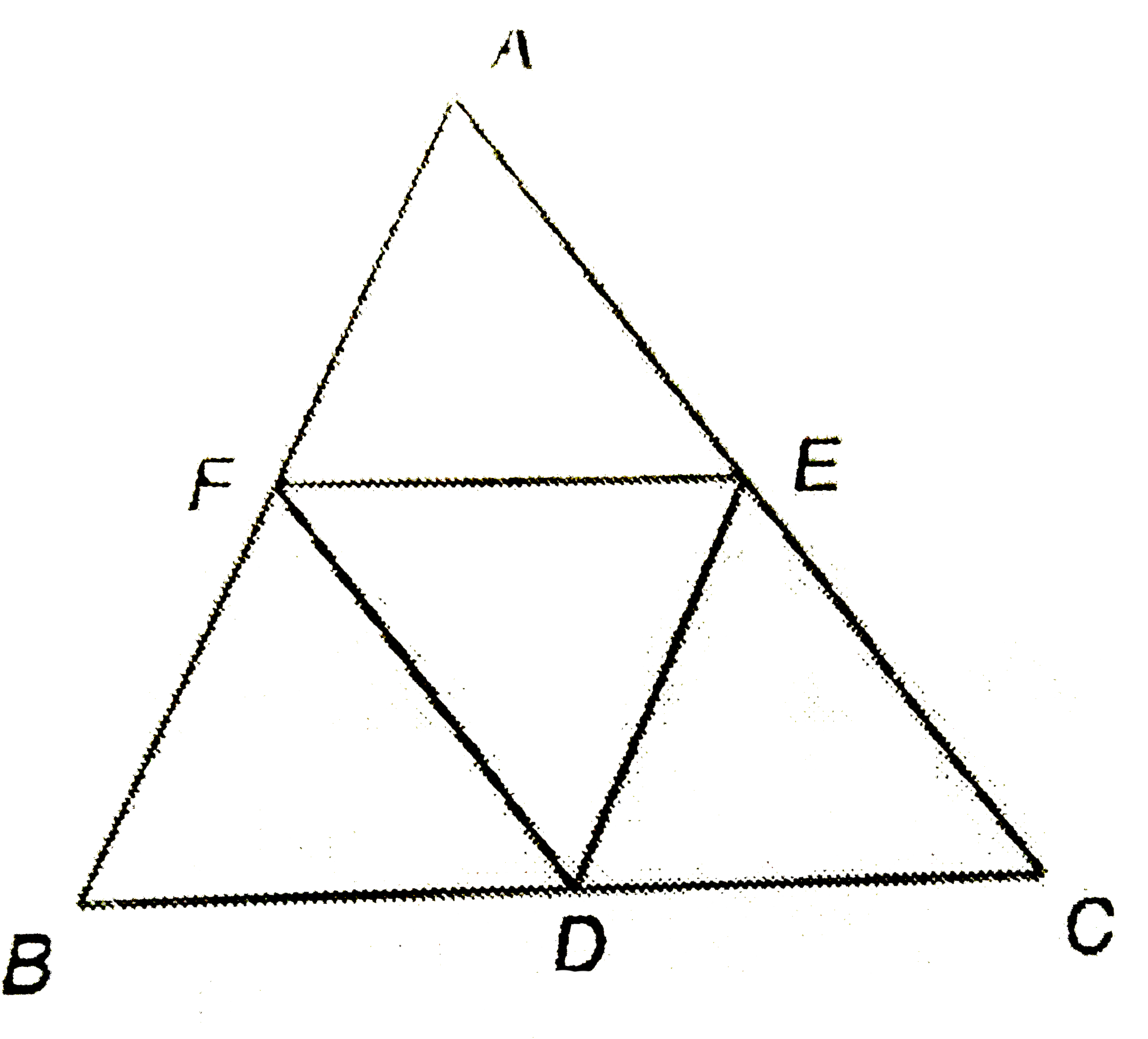D, E and F are respectively the mid-points of the sides BC, CA and AB of a ΔABC. Show that
ar(△DEF)=14ar(△ABC)
To prove that the area of triangle DEF is equal to 14 of the area of triangle ABC, we will follow these steps:
Step 1: Identify the Midpoints
Let D, E, and F be the midpoints of sides BC, CA, and AB of triangle ABC, respectively.
Step 2: Use the Midpoint Theorem
According to the Midpoint Theorem, the line segment joining the midpoints of two sides of a triangle is parallel to the third side and half as long. Therefore:
- EF is parallel to BC and EF = 12BC
- DF is parallel to AC and DF = 12AC
- DE is parallel to AB and DE = 12AB
Step 3: Show that DEF is a Parallelogram
Since EF is parallel to BC and DE is parallel to AB, and both pairs of opposite sides are equal (EF = 12BC and DE = 12AB), quadrilateral DEFB is a parallelogram.
Step 4: Area of Triangle DEF
The area of triangle DEF can be expressed in terms of the area of triangle ABC. The area of a triangle is given by:
Area=12×base×height
In triangle ABC, the base can be taken as BC and the height from A to BC. The area of triangle ABC is:
AreaABC=12×BC×h
where h is the height from A to BC.
Step 5: Relate the Areas
Since EF is half of BC, the height from D to EF will also be half of the height from A to BC (because D is the midpoint). Thus, the area of triangle DEF is:
AreaDEF=12×EF×height from D to EF
Substituting EF = 12BC and the height from D to EF = 12h:
AreaDEF=12×(12BC)×(12h)=18BC×h
Step 6: Final Calculation
Now, we can relate the area of triangle DEF to triangle ABC:
AreaDEF=18BC×h=14(12BC×h)=14AreaABC
Conclusion
Thus, we have shown that:
AreaDEF=14AreaABC
Let D, E, and F be the midpoints of sides BC, CA, and AB of triangle ABC, respectively.
According to the Midpoint Theorem, the line segment joining the midpoints of two sides of a triangle is parallel to the third side and half as long. Therefore:
- EF is parallel to BC and EF = 12BC
- DF is parallel to AC and DF = 12AC
- DE is parallel to AB and DE = 12AB
Since EF is parallel to BC and DE is parallel to AB, and both pairs of opposite sides are equal (EF = 12BC and DE = 12AB), quadrilateral DEFB is a parallelogram.
The area of triangle DEF can be expressed in terms of the area of triangle ABC. The area of a triangle is given by:
Area=12×base×height
In triangle ABC, the base can be taken as BC and the height from A to BC. The area of triangle ABC is:
AreaABC=12×BC×h
where h is the height from A to BC.
Since EF is half of BC, the height from D to EF will also be half of the height from A to BC (because D is the midpoint). Thus, the area of triangle DEF is:
AreaDEF=12×EF×height from D to EF
Substituting EF = 12BC and the height from D to EF = 12h:
AreaDEF=12×(12BC)×(12h)=18BC×h
Now, we can relate the area of triangle DEF to triangle ABC:
AreaDEF=18BC×h=14(12BC×h)=14AreaABC
Thus, we have shown that:
AreaDEF=14AreaABC
Topper's Solved these Questions
- BOOK - MTG IIT JEE FOUNDATIONCHAPTER - AREAS OF PARALLELOGRAMS AND TRIANGLESEXERCISE - NCERT SECTION ( EXERCISE 9.4)19videos
AREAS OF PARALLELOGRAMS AND TRIANGLES
- BOOK - MTG IIT JEE FOUNDATIONCHAPTER - AREAS OF PARALLELOGRAMS AND TRIANGLESEXERCISE - EXERCISE ( Multiple Choice Questions )45videos
AREAS OF PARALLELOGRAMS AND TRIANGLES
- BOOK - MTG IIT JEE FOUNDATIONCHAPTER - AREAS OF PARALLELOGRAMS AND TRIANGLESEXERCISE - NCERT SECTION ( EXERCISE 9.2)7videos
AREAS OF PARALLELOGRAMS AND TRIANGLES
- BOOK - MTG IIT JEE FOUNDATIONCHAPTER - CIRCLES EXERCISE - OLYMPIAD/HOTS CORNER6videos
CIRCLES
Similar Questions
Knowledge Check
- Question 1 - Select One
If D, E and F are respectively the mid - points of sides BC, AC and AB of a ΔABC. If EF=3cm,FD=4cm and AB=10cm, then DE,BCandCA respectively will be equal to :
A6, 8 and 20 cmB4, 6 and 8 cmC5, 6 and 8 cmD103, 9 and 12 cm
D, E and F are respectively the mid-points of the sides BC, CA and AB of aΔABC.Show that (i) BDEF is a parallelogram. (ii) ar (DEF)=14ar (ABC)(iii) ar (BDEF)=12ar (ABC)
View SolutionD, E and F are the mid-points of the sides BC, CA and AB of a triangle ABC. Show that
BDEF is a parallelogramView SolutionIf E,F,G and H are respectively the mid-points of the sides of a parallelogram ABCD, show that ar(EFGH)=12ar(ABCD).
View SolutionIf E, F, G and H are respectively the mid-points of the sides of a parallelogram ABCD, Show that ar(EFGH)=12AR (ABCD)
View SolutionIn Figure, D,E and F are, respectively the mid-points of sides BC,CA and AB of an equilateral triangle ABC . Prove that DEF is also an equilateral triangle.
View SolutionD, E and F are the mid-points of the sides BC, CA and AB, respectively of and equilateral ΔABC. Show that ΔDEF is also an equilateral triangle.
View SolutionIn the adjoining figure D, E and F are the mid-points of the sides BC, CA and AB of the equilateral ΔABC. Prove that ΔDEF is also an equilateral triangle.
 View Solution
View Solution

